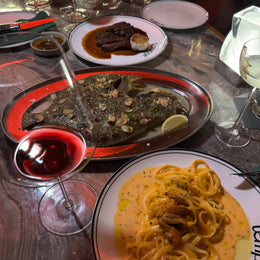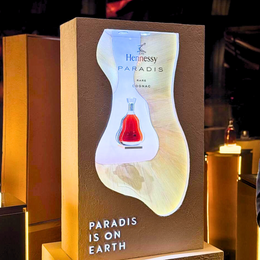
Before I learnt what “Black Tot Day” was, I’ll admit, I thought it sounded a bit ominous. I knew it was somewhat related to rums and the sea. Were people commemorating some kind of naval disaster because the captain drank too much rum? Or a somber remembrance of a ship lost at sea? It turns out, my instincts about on-board intoxication were at least in the right direction.
I recently had the chance to join the good folks at La Maison du Whisky (LMDW) for drinks and a commemoration of “Black Tot Day” (31st July) at their Robertson Quay bar, where we learnt more about this ominous-sounding occasion and the history behind it.

This evening was led by the passionate and knowledgeable Daniele Biondi, the export manager of La Maison & Velier, who came armed with several bottles of Velier’s iconic rums and the promise we could try them if we could sit through his important lecture about the history of rums and why Black Tot Day was such a pivotal moment in naval and rum history.

A brief history of intoxicating substances and the military
While you may raise the eyebrows of your bartender if you think of driving a car after a few drinks, the picture of a tipsy sailor fumbling with a warship’s cannon seems utterly bonkers. Yet governments throughout history seem to have missed the memo, freely doling out mind-altering substances to their soldiers with the casualness of a bartender serving happy hour specials. French soldiers in the trenches of both World Wars were fortified by copious amounts of red wine, while German and Finnish solders were popping methamphetamine pills like mints - talk about a different kind of buzz!

Rum rations were probably the biggest exercise in alcohol distribution in modern history - the British Royal Navy helped bring rums to wherever a ship could go to. (Image Source: Radio Canada International)
When it came to British Navy, the substance of choice had been rum. In fact, for centuries, rum wasn't just a drink; it was a lifeline, a tradition, and an integral part of British naval life. But how did rum become so entrenched in naval life?

Initially, the Navy considered a brandy ration, but that idea was quickly scrapped because brandy was often the drink of the (French) enemy.
In the early days of sailing, water stored on ships quickly turned stale and unsafe to drink. Solders were stuck at sea for months with nothing but a foul-tasting, algae-ridden concoction to quench their thirst. Therefore, in the early 1600s, British sailors were given a weak beer (known as “small beer”) which contained low amounts of alcohol but was much less likely to spoil while at sea. However, as the navy expanded and voyages grew longer, carrying large volumes of beer for all the sailors became impractical. It's hard to maintain naval supremacy when your ships were slowed down by large barrels of ale.

The answer came after the British captured Caribbean islands like Jamaica, which were able to produce lots of rum. Suddenly, the Navy had access to a spirit that was both compact and potent. Rum rations, known as the "daily tot" were introduced, and it became a tradition that would last for centuries.
While this may seem ill advised, rum served an important role on the ship. It helped to sanitise stagnant water teeming with microbes. Rum was also believed to have medicinal properties, and when drunk with a wedge of lime, the Vitamin C from the lime unknowingly helped sailors ward off diseases like scurvy. In a way, this rum cocktail worked like a multivitamin with a kick.
Beyond its practical uses, rum played a crucial role in maintaining morale and order. The stress of being crammed into a wooden ship with hundreds of other men, facing storms, battles and the constant threat of mutiny could get overwhelming. This made a daily dose of rum a welcome respite and a ritual that fostered camaraderie. It was also a reward system, used to incentivize good behaviour and punish infractions. Think of it as a carrot-and-stick approach, but with a generous serving of alcohol.

Initially, sailors were given a whooping half-a-pint of neat rum per day - that's about 284 milliliters of liquid courage that clocked clocking in at a hefty 40-50% ABV. This was equivalent to downing about 9 shots of vodka a day. Such a heroically large amount of alcohol began to raise concerns – it felt like common sense that a ship full of intoxicated sailors is hardly a recipe for smooth sailing. Therefore in 1740, Admiral Edward Vernon who was nicknamed "Old Grog" for his grogram (silk and wool) cloak ordered the Navy to dilute the rum with water – a drink that was later called “grog”. Sailors were still given the same amount of rum, but the reduced alcohol proof helped to keep things a bit more under control.

The influential Admiral Edward Vernon who was known for wearing coats made of grogram introduced the practice of diluting rum with water; the mixture in turn became known by sailors as "Grog".
As the Navy modernized and the demand of naval warfare became more sophisticated, the rum ration was gradually reduced. By the mid-1800s, the Navy was only serving one-eighth of a pint or about 71 ml a day. Sailors could even opt to forgo their tot in exchange for extra pay.
The final nail in the coffin for the daily tot came in the post-WWII era. In December 1969, the British Parliament concluded that the complex machinery and dangerous equipment on board warships should not be operated by sailors who were seeing double. And so, on 31 st July 1970, the rum ration in the British Navy was officially abolished. Sailors were photographed raised their final glasses of grog, mourning the end of a centuries-old tradition. The remaining rum was stored away in a shipyard and seemingly forgotten.

Flagons of the pre-1970 British Navy rum.
What goes into British Navy Rum?
Now, for the spirits geeks out there, you might be wondering, "How exactly was Navy Rum made?" It wasn't a single distillery's product but a blend of rums from various British-controlled colonies. The exact recipe evolved over time, but towards the end of its run in 1970, the blend was approximately 60% Demerara rum from Guyana, known for its rich, full-bodied character, 30% Trinidad rum, adding a touch of elegance and spice, and 10% from other colonies like Barbados and Australia, and potentially even Singapore.
It's thanks to this long-standing tradition that you'll still see all sorts of references to the Navy in the rum and spirits world today. Terms like "Navy Rum," "Gunpowder Proof," and "Navy Strength" evoke images of swashbuckling sailors and epic sea battles with pirates. But while many producers try to capture the essence of those fabled decades, no one can quite replicate the flavour of the real navy rum. It was a unique blend made with rums from distilleries that no longer exist today.
Uncovering Black Tot’s Last Consignment

Read our rum diarist's review of the Black Tot Last Consignment Navy Rum (Source: Weixiang Liu)
Now, remember how we mentioned that after the rum rations were stopped on Black Tot Day, there was still a lot of leftover rum left in a forgotten shipyard? Well, this led to a bit of a treasure hunt with modern day rum enthusiasts.
One such adventurer was Sukhinder Singh, the co-founder of the renowned The Whisky Exchange. In 2010, he managed to track down the remaining flagons of the Navy Rum and purchased them from the Navy. He then bottled this precious liquid under the label "Black Tot Last Consignment." With an outturn of just 3,000 bottles, the Black Tot Last Consignment is now one of the most sought after rum bottlings in the world as it offer a taste of history and a glimpse into the heart of the Royal Navy's rum tradition.

Founder of the iconic The Whisky Exchange, Sukhinder Singh (Source: Club Oenologique)
Rum Tasting
Daniele came armed not just with historical knowledge, but also with several rum bottlings and was ready to transport us back to the days of the daily tot as we commemorated Black Tot Day with rum.

The first offering was the Veritas White Rum. This is a Velier-made blend of aged pot still rum from Foursquare, unaged column still rum from Foursquare, and pot still rum from Hampden Estate. This unique blend was meant to be an affordable, easy-to-drink rum that retains tons of esters and aromas while also being appropriate for mixing in cocktails.

While it was billed as an easy-drinking rum, it was far from simplistic. The nose was a burst of green freshness. It blossomed, revealing a sweetness akin to brown sugar and overripe raspberries, all underpinned by a creamy note and a whisper of pepper. The palate was also delightful - the texture clung gently, offering a clean, mild sweetness that was both approachable and balanced. As it lingered, a pleasing dryness emerged, accompanied by distinct notes of vanilla and ginger that warmed the palate and left a comforting glow. It was a flavourful rum that was as easy to sip as it was layered.
Next came the Hampden 8-year-old, a classic Jamaican rum that needed little introduction. This is the flagship entry-range expression from Jamaica's most iconic rum distillery, known for producing rums with a distinct funky character. This particular rum had been aged for 8 years in the tropical climate of Jamaica.

The aroma was a tropical fruit galore - ripe bananas, a medley of exotic fruits, and the comforting scent of banana bread. The palate echoed these notes, with the banana and tropical fruit taking centre stage, joined by pineapple, vanilla, and a hint of caramelised apple. A subtle savouriness and light spice added depth, leading to a savoury finish with a whisper of vegetal notes. It was a perfect introduction to the bold, ester-y profile of Jamaican rums, and its lower proof made it approachable even for those new to the world of rum.
The Velier Royal Navy Tiger Shark was next, a blend shrouded in a bit of mystery. Velier’s attempt at recreating a navy-style rum, it was a blend of pot-stilled rums from the British West Indies, all tropically aged for an average of 14 years.

The nose was refined yet bursting with flavour - caramel, cinnamon, ripe raspberries, and a touch of overripe banana and gasoline. It was powerful and estery, with hints of apricot and monk fruit. The palate was lively and punchy, with spices mellowing into sweet caramel and mint, followed by liquorice, pepper, candied orange peel, and roasted pineapple. Woody notes of cinnamon and coffee lingered on the finish. It was a challenging rum, offering a multitude of nuances and heat. While the spice occasionally threatened to dominate, the underlying complexity shone through and it was a rewarding experience.
Finally, we concluded with the Black Tot Finest Caribbean Rum , a modern interpretation of the navy style. Like its historical counterpart, it leaned heavily on Demerara rum, with 40% aged and 20% unaged Guyana rum forming its backbone. The remaining was 35% Barbados rum, and a final 5% of high-ester Jamaican pot still rum which added a whisper of funk.

The nose was a tropical paradise - ripe banana, pineapple, and mango danced with molasses and brown sugar. The palate was smooth and full-bodied, with caramelised sugar and toffee balanced by the bright, juicy fruit notes. The spice from the nose reappeared, with black pepper and ginger providing warmth. It was an approachable rum, showcasing the influence of the Demerara component with its abundance of caramelised sugar and molasses.
Blending our very own rum
Just as we were settling into a nostalgic rum-fuelled haze, Daniele whipped out measuring cylinders and pipettes, and suddenly I felt like I was back in school in a chemistry class. We were then invited to unleash our creativity and blend our own rums.

Because I enjoyed the funkiness of Hampden and the rich molasses-forward character of the Black Tot Finest Caribbean, I decided to blend them together to see what I got. My working theory was that the bold, funky character of the Hampden ought to be balanced out by the rich, molasses-forward profile of the Black Tot, making the overall profile slightly more complex, with a balance of sweetness, caramel and some funky notes of overripe fruits. Or so I thought.

And so I began with 30mls of the tamer-tasting Black Tot in the measuring cylinder, before pouring in about another 15ml of Hampden. The profile did not seem to stray much from the Black Tot – had the same sweetness of ripe tropical fruits and spices, with a very faint funky edge. Looking for bit more of a robust kick, so I emptied all the Hampden in. Alas! That was a mistake.

It looks better than it tastes: my ill-conceived blended concoction which was a waste of both Hampden and Black Tot.
The overall profile just appeared to have become muddled - all of the heavy oaky character from the aged Hampden seemed to have quickly overwhelmed the fruitiness of the Black Tot.
This little experiment is a fun reminder that blending spirits in general isn’t a straightforward exercise at all. It seems like the flavours do not interact linearly – even the slightest change in proportion can dramatically alter the final product. I should probably have used the pipette for the addition. You’ve gotta have patience, tons of rum to re-experiment, and develop a keen understanding of how different flavours interact. But that's also the beauty of the art of blending — there're endless possibilities, the thrill of discovering synergies, and the chance to create a really unique blend. If you have the right tools and spirit to do so, that is.
A royal toast to rum
It it wasn't clear by now, the British Navy's historical method of blending rums wasn't just a haphazard mix-and-match. The immense quality enjoyed by rum lovers in the Black Tot Last Consignment expressions is proof of the quality of the distillate and the Navy’s rum blending prowess that has been developed through the centuries of issuing rum rations.
While it isn’t his main duty, the Royal Navy's Purser (also called the “Pusser” by sailors), the officer responsible for money and cargo administration and supply had to oversee the blending of these rums. He was responsible for ensuring that the rum issued to the sailors met the standards and consistency expected of Navy rum and sailors relied upon him to ensure that each daily tot was of the same proof and high enough quality to keep spirits high.

So, as we raise a glass to Black Tot Day, let's not just remember the end of an era but also celebrate the rich history and craftsmanship that went into every tot of Navy rum. Here’s a toast to resilience, courageous voyages and perhaps a touch of madness that have defined the British Navy for centuries! And another toast to the talented Purser-officers of old who had to juggle between managing rowdy sailors and honing the art of blending rum at the same time!

@CharsiuCharlie







